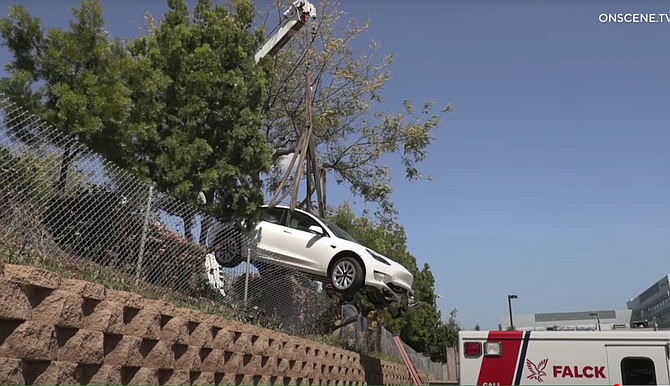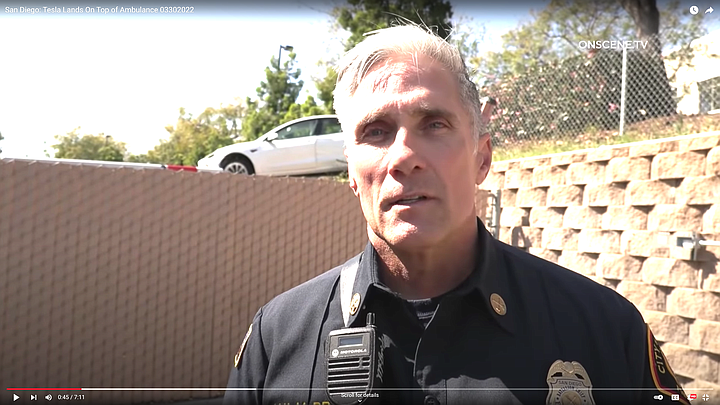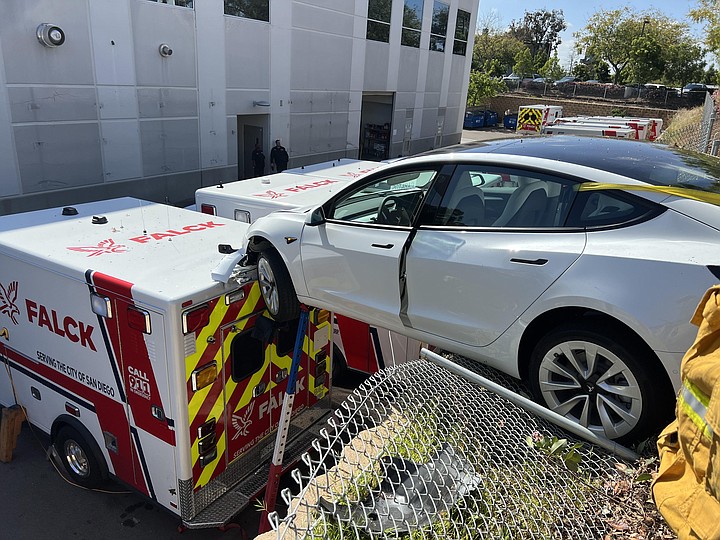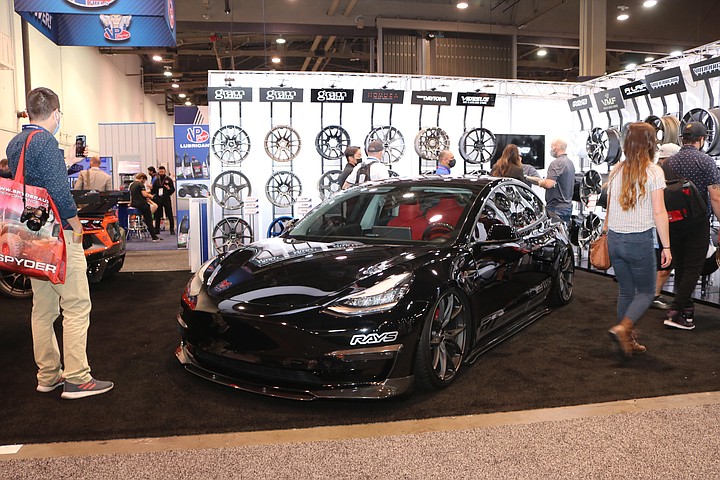 Facebook
Facebook
 X
X
 Instagram
Instagram
 TikTok
TikTok
 Youtube
Youtube

A Tesla that recently landed on top of an ambulance in Kearny Mesa stole the thunder from a flying Tesla in Los Angeles days before.
Above the Falck Ambulance Service headquarters, before 10 am on March 30, an unidentified driver of a white-colored Tesla Model 3 hopped a curb, then crashed into a fence behind the San Diego County Public Health Center parking lot by Ruffin Road and Greencraig Lane. The driver reportedly stepped on the accelerator pedal rather than the brake pedal. As a result, the 480 horsepower electric vehicle rolled down a slope, jumped a cement wall, and partially landed on top of a Falck ambulance parked below. The front bumper rested on the roofline of the red-and white-colored ambulance while the 18-inch wheels up front hovered about seven feet in mid-air. The fire department grew concerned regarding the "stacked stone wall" supporting the 4000-pound vehicle's midsection and rear end, noting it's "not a masonry wall, so the integrity is at risk."

From specific vantage points, the Elon Musk-created vehicle appeared as if it were hovering — sort of like the flying DeLorean image he's been Tweeting for the last couple of years. Musk, now the "richest man in the world," is claiming to launch a Tesla Roadster this year with an optional SpaceX rocket thruster package to make it fly.
Some San Diegans say the Tesla that crashed about a mile southwest of the I-15 and Clairemont Mesa Boulevard exit was a flying car. It cleared what appeared to be a four-foot gap between the wall — and "not the Falcking ambulance?" questioned Megan S. underneath a photo snapped by the San Diego Fire-Rescue Department.

"There's an opportunity for the vehicle to fall down onto a wall behind the ambulance and would damage the battery tray," said Battalion Chief Mike McBride of the fire department in an OnScene.TV clip. "These lithium batteries cause a whole different problem once they're opened and released, and if any kind of water gets in there, it could be a serious fire hazard."
Ali, the owner of Guardian Towing Inc. by Miramar Road, was one of the first people on the scene with his tow truck. "Initially, we tried pulling the vehicle back, but they told us to halt," Ali said to me in an April 5 interview. "Then they decided to deadlift the vehicle with a crane."

On the OnScene.TV video footage, Ali is depicted at the rear of the Tesla assisting in the rescue. He texted me photos from his vantage point showing four additionally parked ambulances and a firetruck surrounding the accident scene below.
"That just happened to be one of our ambulance provider's ambulances," continued the battalion chief.
The fire department strapped harnesses inside the Tesla's four opened windows and pulled the vehicle up above the fence it mowed over earlier that Wednesday morning. "Lifting the vehicle was the better idea," Ali continued. "They didn't want to damage the battery because those batteries are highly flammable if they get punctured."
Ali knows about Teslas. Since the year started, he towed three Teslas that went out of range. "That means the battery goes dead," Ali said, "and the driver didn't get to a charging station quick enough."
The five-seater Tesla that crashed has an estimated 270-350 mile range on a full charge, depending on if it's a standard, mid- or long-range version Model 3. The charge costs about $9 and takes 30 minutes at a Tesla Supercharger station.
Ali added that his company has towed a few Teslas because of their flat tires; "they don't have spare tires. Since the year started, I towed four other Teslas that wrecked, and no one died. They are safe vehicles; the batteries are on the bottom, and they are bottom heavy vehicles, so they do not roll over."
The San Diego Fire Department tweeted, "The driver and the two passengers were transported to a local hospital for unknown injuries." None of the Falck ambulance headquarters employees were injured.
The Tesla-versus-ambulance news clips gained traction by drawing traffic from the millions of viewers watching another flying Tesla that went viral days before.
On March 20, about 120 miles north of San Diego, an unidentified person rented a 2018 Tesla Model S and drove it to the Echo Park neighborhood in Los Angeles. In the incriminating videos posted on YouTube, Instagram, and TikTok that Sunday morning, the rogue driver of the black-colored 1020 horsepower Tesla drove a reported "50 miles per hour" up a street that led to a hilltop. As the vehicle reached the crest, its 20-inch wheels left the pavement, and the 4000-pound car flew for a second or so, then landed on its front bumper and wheels at an estimated "50 feet" from the launching point on the other side, careening into two parked vehicles and trash bins. The four people inside, one allegedly holding a cat in hand, disembarked from the car, jumped into another Tesla, and sped off. The driver of the flying Tesla, who rented the vehicle, is wanted by the L. A. Police.
As this article goes to print, a YouTube video of the Los Angeles Tesla was viewed over two million times in a short period. When a video is viewed on the video-sharing platform, a running list of thumbnails on the right side leads to similar content. So when worldwide news outlets uploaded the San Diego Tesla story onto their YouTube pages, their news article thumbnails algorithmically latched onto the Los Angeles Tesla video and vice versa.
Ron Villarin, a Paradise Hills Tesla customizer, saw the trending Teslas on the internet. "I didn't like that this guy in Los Angeles was doing it for clout," he said in an April 4 interview. "He's making us look bad." Villarin is part of Ruined Tesla, a group that airbags the suspension of their Teslas and drops 'em to the pavement to lowride. While there's a small amount of Tesla owners who like to post about their nine-second quarter-mile runs, and some boast about breaking off an unsuspecting exotic car driver, Villarin assures their critics that most Tesla owners are humble and lie low. "My idea is to open people's eyes so they can fix up Teslas just as nice as other cars, not destroy them."


A Tesla that recently landed on top of an ambulance in Kearny Mesa stole the thunder from a flying Tesla in Los Angeles days before.
Above the Falck Ambulance Service headquarters, before 10 am on March 30, an unidentified driver of a white-colored Tesla Model 3 hopped a curb, then crashed into a fence behind the San Diego County Public Health Center parking lot by Ruffin Road and Greencraig Lane. The driver reportedly stepped on the accelerator pedal rather than the brake pedal. As a result, the 480 horsepower electric vehicle rolled down a slope, jumped a cement wall, and partially landed on top of a Falck ambulance parked below. The front bumper rested on the roofline of the red-and white-colored ambulance while the 18-inch wheels up front hovered about seven feet in mid-air. The fire department grew concerned regarding the "stacked stone wall" supporting the 4000-pound vehicle's midsection and rear end, noting it's "not a masonry wall, so the integrity is at risk."

From specific vantage points, the Elon Musk-created vehicle appeared as if it were hovering — sort of like the flying DeLorean image he's been Tweeting for the last couple of years. Musk, now the "richest man in the world," is claiming to launch a Tesla Roadster this year with an optional SpaceX rocket thruster package to make it fly.
Some San Diegans say the Tesla that crashed about a mile southwest of the I-15 and Clairemont Mesa Boulevard exit was a flying car. It cleared what appeared to be a four-foot gap between the wall — and "not the Falcking ambulance?" questioned Megan S. underneath a photo snapped by the San Diego Fire-Rescue Department.

"There's an opportunity for the vehicle to fall down onto a wall behind the ambulance and would damage the battery tray," said Battalion Chief Mike McBride of the fire department in an OnScene.TV clip. "These lithium batteries cause a whole different problem once they're opened and released, and if any kind of water gets in there, it could be a serious fire hazard."
Ali, the owner of Guardian Towing Inc. by Miramar Road, was one of the first people on the scene with his tow truck. "Initially, we tried pulling the vehicle back, but they told us to halt," Ali said to me in an April 5 interview. "Then they decided to deadlift the vehicle with a crane."

On the OnScene.TV video footage, Ali is depicted at the rear of the Tesla assisting in the rescue. He texted me photos from his vantage point showing four additionally parked ambulances and a firetruck surrounding the accident scene below.
"That just happened to be one of our ambulance provider's ambulances," continued the battalion chief.
The fire department strapped harnesses inside the Tesla's four opened windows and pulled the vehicle up above the fence it mowed over earlier that Wednesday morning. "Lifting the vehicle was the better idea," Ali continued. "They didn't want to damage the battery because those batteries are highly flammable if they get punctured."
Ali knows about Teslas. Since the year started, he towed three Teslas that went out of range. "That means the battery goes dead," Ali said, "and the driver didn't get to a charging station quick enough."
The five-seater Tesla that crashed has an estimated 270-350 mile range on a full charge, depending on if it's a standard, mid- or long-range version Model 3. The charge costs about $9 and takes 30 minutes at a Tesla Supercharger station.
Ali added that his company has towed a few Teslas because of their flat tires; "they don't have spare tires. Since the year started, I towed four other Teslas that wrecked, and no one died. They are safe vehicles; the batteries are on the bottom, and they are bottom heavy vehicles, so they do not roll over."
The San Diego Fire Department tweeted, "The driver and the two passengers were transported to a local hospital for unknown injuries." None of the Falck ambulance headquarters employees were injured.
The Tesla-versus-ambulance news clips gained traction by drawing traffic from the millions of viewers watching another flying Tesla that went viral days before.
On March 20, about 120 miles north of San Diego, an unidentified person rented a 2018 Tesla Model S and drove it to the Echo Park neighborhood in Los Angeles. In the incriminating videos posted on YouTube, Instagram, and TikTok that Sunday morning, the rogue driver of the black-colored 1020 horsepower Tesla drove a reported "50 miles per hour" up a street that led to a hilltop. As the vehicle reached the crest, its 20-inch wheels left the pavement, and the 4000-pound car flew for a second or so, then landed on its front bumper and wheels at an estimated "50 feet" from the launching point on the other side, careening into two parked vehicles and trash bins. The four people inside, one allegedly holding a cat in hand, disembarked from the car, jumped into another Tesla, and sped off. The driver of the flying Tesla, who rented the vehicle, is wanted by the L. A. Police.
As this article goes to print, a YouTube video of the Los Angeles Tesla was viewed over two million times in a short period. When a video is viewed on the video-sharing platform, a running list of thumbnails on the right side leads to similar content. So when worldwide news outlets uploaded the San Diego Tesla story onto their YouTube pages, their news article thumbnails algorithmically latched onto the Los Angeles Tesla video and vice versa.
Ron Villarin, a Paradise Hills Tesla customizer, saw the trending Teslas on the internet. "I didn't like that this guy in Los Angeles was doing it for clout," he said in an April 4 interview. "He's making us look bad." Villarin is part of Ruined Tesla, a group that airbags the suspension of their Teslas and drops 'em to the pavement to lowride. While there's a small amount of Tesla owners who like to post about their nine-second quarter-mile runs, and some boast about breaking off an unsuspecting exotic car driver, Villarin assures their critics that most Tesla owners are humble and lie low. "My idea is to open people's eyes so they can fix up Teslas just as nice as other cars, not destroy them."
Comments